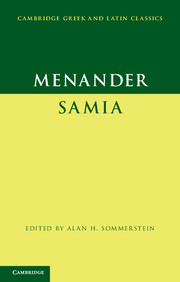No explicit information survives about the date when Samia was produced, and we are forced to rely on internal evidence. This has led different analysts to somewhat different conclusions, often based on rather equivocal evidence, but nearly always placing the play somewhere in the first half of Menander's career.
The most cogent evidence for an early date is the presence of satirical references to three contemporary Athenians, Diomnestus, Chaerephon and Androcles (504, 603, 606–8nn.). There are no such references in any of the other plays of Menander preserved on papyri (not even in the virtually complete, and relatively early, Dyskolos), and only ten in the ‘book’ fragments. Of these ten, four (frr. 264–6, 268) come from Orge, Menander's first play; two (frr. 224, 225) from Methe, which must date from 318 or earlier; one from Androgynos (fr. 55), also likely to be early, since it refers (fr. 51) to the Lamian war of 322; and two from Kekryphalos (frr. 215, 216), which probably dates from the first year or two of Demetrius of Phalerum's rule. Thus, apart from Samia, we have only one possible reference to a contemporary Athenian in a play that may be later than c.315 – fr. 385, from Hypobolimaios, which mentions one Amphietides, whose name had become proverbial for imbecility (and who may therefore not have been a contemporary at all). This is very strong evidence that Samia was produced no later than c.314 – that is, in the first seven years or so of Menander's career – and, in the absence of any objective evidence requiring a later date, this evidence should be accepted.
